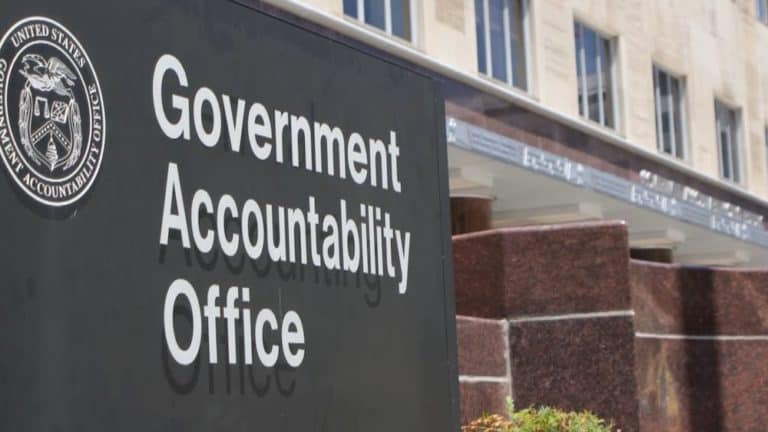VA’s Burn Pit Benefit Reform Delayed, Critics Claim
Veterans suffering from severe lung disease due to exposure to harmful air and waste incineration while serving have faced difficulties in securing disability benefits from the Department of Veterans Affairs (VA).
The VA’s benefit allocation system lacks a specific diagnostic category for constrictive bronchiolitis (CB), a condition associated with military service in Southwest Asia, Afghanistan, and Djibouti post-9/11.
Typically, the VA’s Schedule for Rating Disabilities assigns a numerical code and a corresponding percentage to reflect the severity of a veteran’s disability, which then determines their eligibility for monthly compensation based on the impact of their service-related conditions on their ability to work.
Without a dedicated diagnostic code for CB, most affected veterans are given a disability rating of zero and denied compensation. However, plans are underway to revise the system to include a diagnostic code for CB, potentially enabling affected veterans to receive benefits.
In a conversation with PBS NewsHour, VA Under Secretary for Benefits Joshua Jacobs stated that updating the Rating Schedule to cover CB is a top priority and is being expedited. Additionally, the VA has indicated its intent to potentially add a diagnostic code for CB.
At a recent conference, Dr. Shereef Elnahal, Under Secretary of Veterans Affairs for Health, discussed with attendees the consideration of whether to create a specific code for CB or a broader category termed “Deployment-Related Respiratory Disease,” encompassing CB among other conditions.
The VA plans to finalize these changes and publish them in the Federal Register by September 30, 2024, as informed by insiders familiar with the ongoing discussions.
Impact of Constrictive Bronchiolitis on Veterans
According to a VA staffer with extensive experience on the matter, “There are an estimated 300 to 400 veterans who have been diagnosed with constrictive bronchiolitis or other small airway injuries after receiving lung biopsies.” This number is significantly lower than the prevalence of more common respiratory issues among veterans. As of January 1, 2024, the VA had approved more than 7,000 claims for Chronic Obstructive Pulmonary Disease and over 30,000 claims for asthma.
However, constrictive bronchiolitis (CB) poses a unique diagnostic challenge. Unlike asthma and other respiratory conditions, “CB cannot be diagnosed with traditional lung tests such as X-rays, CT scans or pulmonary function tests (PFT).” The only way to confirm a CB diagnosis is through an invasive lung biopsy, which involves substantial costs and risks.
PBS NewsHour has sought recent data on the number of veterans diagnosed with CB from the VA but has yet to receive a response.
Allyn Harris, a former VA doctor, suggests the current estimate severely underrepresents the true number of affected veterans. She believes that “the 300 to 400 number is ‘a huge underestimation,’” and that the real figure could be “10 times” higher. This underdiagnosis means many veterans may face a difficult journey to receive proper diagnosis and benefits.
Veterans with CB often experience debilitating symptoms. “Veterans with CB experience severe shortness of breath and fatigue when exercising. But ‘most people are told their issues are asthma or are told there is nothing wrong with them when they clearly have symptoms,’” Harris explained, based on her experience as a pulmonologist at the Jackson VA Medical Center from 2014 to 2018.
The personal story of former Army Sergeant Cynthia Aman highlights the everyday challenges faced by veterans with CB. She told PBS NewsHour in 2018, “I find myself struggling, when I pull into a parking lot, even at the grocery store, because I know what’s going to happen. If I have to park in the back of the parking lot, by the time I get inside, I’m so winded that it’s miserable for me to even do my grocery shopping.” Aman’s experience underscores the severe impact of CB on the quality of life for veterans, illustrating the urgent need for accurate diagnosis and treatment.
Addressing a Complex Health Issue
Harris shared her experiences at the VA, highlighting the establishment of a specialized clinic for veterans of the Iraq and Afghanistan wars suffering from an inexplicable shortness of breath. “Patients would get to my clinic and say that they had been asking to see pulmonary for years and couldn’t get a referral because their tests were ‘normal.’”
She recounted to NewsHour her approach to tackling this issue: by urging primary care clinics to send her any veterans experiencing “new onset of cough or shortness of breath since deployment.” This initiative led to a significant increase in the number of veterans she saw—several hundred in total—struggling with unexplained shortness of breath. “It was overwhelming how many there were and that was just in Mississippi.” Among these, Harris noted, about five veterans chose to undergo lung biopsies, all of which confirmed the presence of CB.
Dr. Robert Miller, a Vanderbilt University Medical Center professor of medicine, underscored the challenge of diagnosing this condition through a Defense Department-funded study. The study observed 380 military personnel who experienced shortness of breath during exercise and had been deployed to South West Asia for a minimum of six months. It found that 32 percent remained undiagnosed after a comprehensive series of tests, with none undergoing lung biopsies.
The VA responded to criticisms regarding the process of awarding disability benefits for CB. A spokesperson clarified to NewsHour via email that the absence of a specific diagnosis code for constrictive bronchiolitis does not hinder the provision of disability compensation. “While there is no specific code for constrictive bronchiolitis, this does not impact the benefits that we provide,” the spokesperson asserted.
Current Rating Overview
The Department of Veterans Affairs (VA) provides monthly disability compensation to veterans for “disabilities, diseases, or injuries incurred or aggravated during active military service,” according to VA guidelines. Diseases typically receive a diagnostic code and a corresponding rating schedule.
The VA has disclosed that for conditions like constrictive bronchiolitis, in the absence of a precise diagnostic code, it employs analogous diagnostic codes “based on that veteran’s individual experience and condition, and the severity of their condition, regardless of whether there is a specific code for that condition.” This means that without a specific code for certain conditions, the VA might assign a code related to a similar ailment, such as bronchitis, bronchiectasis, asthma, or emphysema, to determine the level of benefits.
The VA provided data to NewsHour last summer indicating that from October 2018 to July 2023, 48 veterans diagnosed with CB were assigned a 100 percent disability rating, 50 received a 50 percent rating, and 56 were given a zero percent rating. The specific criteria or codes leading to these decisions remain unclear. Despite requests for updated information on CB diagnoses and corresponding disability ratings, the NewsHour has yet to receive a response.
“The absence of a specific code for CB raises questions,” stated Miller, a medicine professor at Vanderbilt University Medical Center. From his perspective, “it is absolutely not the case” that veterans are granted disability compensation under an alternative code.
Miller noted, “There are a lot of patients that I say have CB and then get rated for asthma. There are patients that I say have CB and they also have sleep apnea … They get the 50% for sleep apnea. I have patients who have service-connected CB and get 0%.”
For a veteran with CB to qualify for benefits under a different code, they must exhibit poor results on a pulmonary function test (PFT), be prescribed corticosteroids, or experience severe episodes of lung infections.
“Many of my patients receive a zero percent [disability] rating because their [pulmonary function tests] do not fulfill the criteria for these conditions. Although applying other diagnoses might be a strategy, it hasn’t been effective for CB,” Miller explained.
Kerry Baker, an attorney and former leader of the VA’s legislative and policy team who now advocates for veterans seeking VA benefits, remarked, “The only folks I’ve seen get a 100 percent rating are ones I have had to fight hard for.”
Recommendations from Experts
Among the most outspoken proponents urging the VA to address the challenges associated with the absence of a distinct diagnostic code and rating criteria for CB is Miller.
His pivotal role as the lead researcher for a 2011 study highlighted the health issues faced by soldiers stationed at Fort Campbell, Kentucky, following their exposure to the 2003 Mishraq State Sulfur Mine Plant fire in northern Iraq. This study, along with widespread beliefs, points to constrictive bronchiolitis in veterans as being linked to inhaling smoke from burn pits—enormous fires used at foreign military bases for disposing of various waste materials, including chemical solvents, plastics, car tires, and more.
Miller has been adamant that the VA must “stop saying that veterans are not affected by this … My patients have had to leave military service because of shortness of breath following deployment.” He has criticized the delay since the VA convened two expert committees two years ago, which proposed solutions for the lack of a comprehensive diagnostic code.
From November 2021 to February 2022, the VA’s Airborne Hazards and Burn Pits Center of Excellence, based in New Jersey, gathered a team of experts from both within and outside the VA to recommend diagnostic tests and terminology for respiratory conditions in veterans caused by deployment.
For the first time, this group unanimously defined constrictive bronchiolitis and endorsed the term “Deployment-Related Respiratory Disease,” (DRRD), to encompass CB and similar conditions that impair the lungs’ small airways. DRRD was characterized as a collective of conditions seen in veterans post-deployment, presenting respiratory symptoms, and it became the suggested label for cases remaining undiagnosed after thorough, yet noninvasive, evaluations.
In September 2022, a portion of this group set forth new guidelines for assessing disabilities in veterans with Deployment-Related Respiratory Disease and constrictive bronchiolitis. Highlighting the complexity of diagnosis, they advised, “In light of diagnostic uncertainty, symptom severity should be the primary category for rating rather than any one objective test finding.” Their guidelines proposed that disability ratings should reflect the extent of symptom severity, thereby enabling veterans to secure disability compensation without the need for invasive lung biopsies.
“This test to prove the existence of constrictive bronchiolitis is actually as intrusive in many cases as the disease itself,” remarked VA Secretary Denis McDonough during a September 2022 NewsHour interview, underscoring the significance of the committee’s recommendations.
An Arduous Journey Toward Minimal Advancement
McDonough has advocated for revising the VA’s Schedule for Rating Disabilities to include more effective detection of CB. “We’re updating that set of guidance and that set of regulations for the first time in something like 60 years … to ensure that we’re operating off the most recent up-to-date science,” McDonough remarked at a news conference in June 2022. However, more than a year on, a specific diagnostic code and rating schedule for CB remained absent. “I’m not happy about where this stands. I want to make sure every veteran gets the care and the benefits that they have earned,” McDonough conveyed in an August 2023 interview with NewsHour’s Amna Nawaz.
After another eight months, the situation remained unchanged.
Two years have elapsed since the panel’s recommendations, with the process to amend VA’s regulations remaining “cumbersome,” according to Baker. He, along with other detractors, stated, “I just don’t see anything from my vantage point that tells me it’s actually being treated as an urgent priority.” Efforts from Congress and the White House to amend the system to facilitate veterans’ access to disability compensation have been significant. In August 2022, the PACT Act was enacted by President Joe Biden, classifying constrictive bronchiolitis along with 14 other conditions as “presumptives.” This designation implies that veterans who served in designated war zones and suffer from any of these conditions are presumed to have acquired them through their military service, thereby automatically qualifying them for disability compensation.
The VA asserts the effectiveness of the PACT Act in assisting veterans with these conditions to secure benefits. Yet, without a diagnostic code and rating schedule for CB, complete implementation of the PACT Act remains hampered, argue advocates.
“The VA has been aware of the issue of CB for over two decades,” Rosie Torres, executive director of Burn Pits 360, pointed out. Torres, whose husband Le Roy Torres is afflicted with CB, was present alongside Biden during the PACT Act’s signing. She criticized the VA’s longstanding promises to address this issue, stressing disbelief in these assurances until tangible action is taken. “One and a half years after PACT Act and the fact that VA still does not have a code is ridiculous.”
“The VA has made tremendous progress on expanding benefits, but this has clearly been an area that’s been overlooked,” remarked former VA Secretary Dr. David Shulkin. He underscored the necessity of codes and documentation for system functionality. With the approaching election, Shulkin noted the reluctance of political appointees to implement major policy changes.
“I would just say there’s no time like the present, now’s the time” to introduce a diagnostic code and rating schedule for this condition, he emphasized.
Comedian and veteran advocate Jon Stewart lauded the VA’s efforts post-PACT Act, acknowledging the significant strides made. “They’ve done an awful lot. They’ve really tried to move heaven and earth, I have been impressed with the change of attitude,” Stewart observed. He highlighted the VA’s commitment to not only extending coverage but also ensuring veterans are well-informed. However, he stressed the importance of finalizing this critical aspect: “Everybody’s come too far and suffered too much. We just got to get this last piece.”
FAQS
What is the VA’s Schedule for Rating Disabilities?
Answer: It’s a set of regulations used by the Department of Veterans Affairs to determine veterans’ disability benefits eligibility. Recently, it’s being updated to reflect modern science for the first time in 60 years.
What changes are being made for CB detection?
Answer: The VA is updating their regulations to improve detection methods for Constrictive Bronchiolitis (CB), aiming to use the latest science.
Has a diagnostic code for CB been established?
Answer: As of August 2023, no diagnostic code or rating schedule for CB has been established, despite efforts and expressed dissatisfaction by Secretary McDonough.
What is the PACT Act’s relevance to CB?
Answer: The PACT Act designates CB as a presumptive condition for veterans, simplifying disability compensation claims. However, without a specific diagnostic code for CB, full implementation is hindered.
Why is assigning a diagnostic code to CB important?
Answer: A diagnostic code is essential for the VA to recognize and compensate CB as a service-connected condition effectively, crucial for implementing the PACT Act and supporting veterans.





Had Bin Laden’s people crashed into VA facilities instead, there wouldn’t have been 20 years of war.